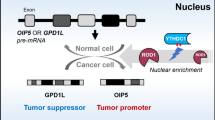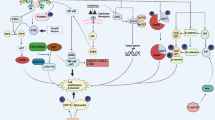Abstract
CD44, the predominant vertebrate cell surface receptor for hyaluronan, exists in a variety of isoforms resulting from alternative splicing of a single gene. Particular spliced variants of CD44 correlate with increased cell motility, and with poor clinical prognosis in several kinds of carcinomas. Combinations of 9 variant exons that confer this enhanced motility on tumor cells are inserted into a single site in the middle of the extracellular domain of CD44. Evidence suggests that phosphorylation of 2 serine residues in the intracellular domain of CD44 are involved in controlling these events. However, evidence is lacking as to the nature of such kineses. Acidic amino acids in close proximity to these 2 serine residues suggests casein kinase II (CKII) is involved. We now show an antisense phosphorothioate oligonucleotide designed to hybridize to the AUG translation initiation codon of subunit CKII α mRNA blocks in vivo phosphorylation of CD44 in MDA231 breast tumor cells, and at the protein level decreases ectopic expression of total CD44 as well as the metastatic v-7 CD44 isoform. Furthermore subplateau RT-PCR analysis demonstrated antisense transfected MDA231 tumor cells had significant down-regulated or eliminated mRNA transcripts of metastatic CD44 isoforms. CKII as a CD44-associated serine kinase therefore may serve as an important molecule in a signaling cascade that produces a variety of cellular reponses in MDA231 breast cancer cells. Since the 3′-untranslated region of CD44 mRNA contain 4 dispersed AUUUA sequences which serve as signals targeting mRNA for rapid turnover, a mechanism is proposed by which CD44 phosphorylation mediates labile message stabilization, hence providing insights into the processes involved in cancer cell growth, invasion and metastasis.
Similar content being viewed by others
References
Backer JM et al.: Phosphatidylinositol 3′-kinase is activated by association with IRS-1 during insulin stimulation. EMBO J 11: 3469-3479, 1992
Screaton GR et al.: Genomic structure of DNA encoding the lymphocyte homing receptor CD44 reveals at least 12 alternatively spliced exons. Proc Natl Acad Sci USA 89: 12160-12164, 1992
Isacke CM et al.: Identification and characterization of the human Pgp1 glycoprotein. Immunogenetics 23: 326-332, 1986
Carter WG, Wayner EA: Characterization of the class III collagen receptor, a phosphorylated transmembrane glycoprotein expressed in nucleated human cells. J Biol Chem 263: 4193-4201, 1988
Neame SJ, Isacke CM: Phosphorylation of CD44 in vivo requires both Ser323 and Ser324, but does not regulate membrane localization or cytoskeletal interaction in epithelial cells. EMBO J 11: 4733-38, 1992
Kennelly PJ, Krebs EG: Consensus sequences as substrate specificity determinants for protein kineses and protein phosphatases. J Biol Chem 266: 15555-15558, 1991
Allende JE, Allende CC: Protein kinase CK2: An enzyme with multiple substrates and a puzzling regulation. FASEB J 9: 313-324, 1995
Munstermann K et al.: CKII is elevated in solid tumors and rapidly proliferating non-neoplastic tissue. Eur J Biochem 189: 251-257, 1990
Chiang MY et al.: Antisense oligonucleotides inhibit intracellular adhesion molecule 1 expression by two distinct mechanisms. J Biol Chem 266: 18162-18171, 1991
Nip J et al.: Coordinated expression of the vitronectin receptor and the urokinase-type plasminogen activator receptor in metastatic melanoma cells. J Clin Invest 95: 2096-2103, 1995
Iida N, Bourguignon L: New CD44 splice variants associated with human breast cancers. J Cell Physiol 162: 127-133, 1995
Bennett FC et al.: Inhibition of endothelial cell adhesion molecule expression with antisense oligonucleotides. J Immunol 152: 3530-3540, 1994
Pure' E et al.: Defective phosphorylation and hyaluronate binding of CD44 with point mutations in the cytoplasmatic domain. J Exp Med 181: 55-62, 1995
Daaka Y, Wikstrom E: Target dependence of antisense oligonucleotide inhibition of c-Ha-ras p21 expression and focus formation in Y24-tansformed NIH3T3 cells. Oncogene Res 5: 267-275, 1990
Seldin DC, Leder P: Casein kinase IIα transgene-induced murine lymphoma: Relation to theileriosis in cattle. Science 267: 894-897, 1995
Uff CR et al.: Hyaluronan binding by CD44 is regulated by a phosphorylation-independent mechanism. Eur J Immunol 25: 1883-1887, 1995
Hauguel-de-Mouzon S et al.: Glucose-induced stimulation of human insulin-receptor mRNA and tyrosine kinase activity in cultured cells. Biochem J 305: 119-124, 1995
Belasco JG: In: J.G. Balasco, G. Brawerman (eds). Control of Messenger RNA Stability. Academic Press, 1993, pp 3-12
Sachs AB: Messenger RNA degradation in eukaryotes. Cell 74: 413-426, 1993
Schiavi SC et al.: Regulation of proto-oncogene mRNA stability. Biochim Biophys Acta 1114: 95-106, 1992
Rajagopalan LE, Malter JS: Modulation of granulocytemacrophage colony-stimulating factor mRNA stability in vitro by the adenosineuridine binding factor. J Biol Chem 269: 23882-23888, 1994
Ohh M et al.: Regulation of intracellular adhesion molecule-1 gene expression involves multiple mRNA stabilization mechanisms: Effects of interferon-γ and phorbol myristate acetate. Blood 84: 2632-2639, 1994
Malter JS, Hong Y: A redox switch and phosphorylation are involved in the post-translational up-regulation of the adenosine-uridine binding factor by phorbol ester and ionophore. J Biol Chem 266: 3167-3171, 1991
Zahalka M et al.: Lymph node (but not spleen) invasion by murine lymphoma is both CD44-and hyaluronate dependent. J Immunol 154: 5345-5355, 1995
Avdalovic M, Fong D and Formby B: Adhesion and costimulation of proliferative responses of human γδ T cells by interaction of VLA-4 and VLA-5 with fibronectin. Immunol letters 35: 101-108, 1993
Author information
Authors and Affiliations
Rights and permissions
About this article
Cite this article
Formby, B., Stern, R. Phosphorylation stabilizes alternatively spliced CD44 mRNA transcripts in breast cancer cells: Inhibition by antisense complementary to casein kinase II mRNA. Mol Cell Biochem 187, 23–30 (1998). https://doi.org/10.1023/A:1006865721693
Issue Date:
DOI: https://doi.org/10.1023/A:1006865721693




